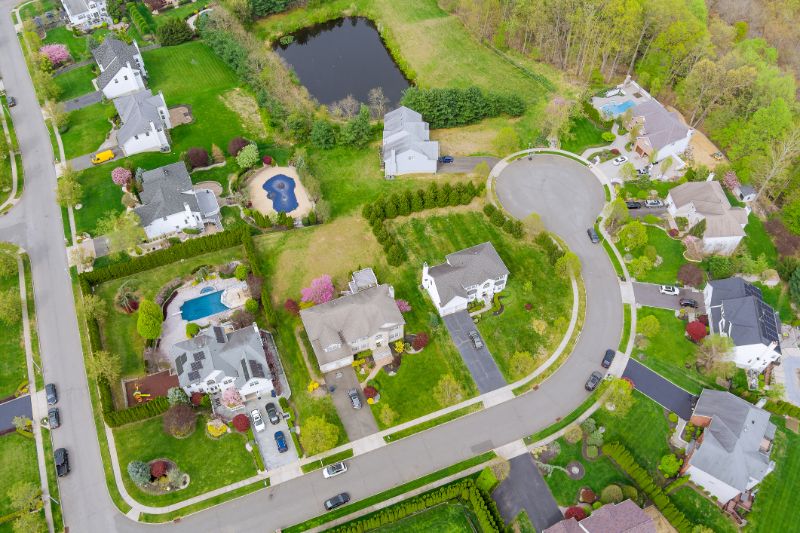
California is known for its abundant natural beauty and vibrant cities. For many people, the Golden State is an ideal place to live. However, affordable housing is hard to come by.In places like Los Angeles and the Bay Area, housing prices have gone through the roof due to high demand and not enough inventory.
This could change in a few years. With Senate Bills 9 and 10 signed into law in September 2021, California has mostly eliminated single-family zoning across the state.
Senate Bill 9, or the California Housing Opportunity and More Efficiency (HOME) Act makes it easier for a homeowner to build a duplex or a multifamily structure on their property or to subdivide their existing lot.
Senate Bill 10 allows local governments to rezone for up to 10 homes or residential units per parcel of land in an urban area or in lots close to mass transit.
There is a lot to unpack about the zoning changes in California and its effect on people with properties in the Golden State, as well as on buyers who are looking to move here.
Therefore, this article will:
-
- Examine the elimination of single-family zoning in California
-
- Provide you with the provisions of Senate Bills 9 and 10
-
- Show you the pros and cons of both bills
Table of Contents
- What is single-family zoning in California?
- Background of single-family zoning in California
- The origin of single-family zoning
- The pros and cons of single-family zoning
- Opponents of single-family housing say
- How single-family zoning in California led to higher prices
- FAQs on single-family zoning in California
- Prepare for the elimination of most single-family zoning in California with Top Realtor Martin Feinberg
What is single-family zoning in California?

Zoning dictates what type of building can be constructed in a certain area. Homes, apartments, townhouses, and condominiums can be built in residential zones. It’s also possible for downtown areas to feature mixed-use zoning, such as a high-rise condominium that contains ground-floor retail businesses and residential units on its higher floors.
Single-family zoning is a legal classification in the United States that restricts the specific type of residential housing that can be constructed on a certain piece of land. Under a single-family zoning restriction, only single-family detached homes can be built in these areas. This type of zoning restriction prohibits the construction of multifamily residential housing like condominiums, townhomes, or duplexes, which can often be found in denser communities.
Critics of single-family zoning say it is exclusionary, implicitly denying people of color access to White neighborhoods. As much as 75% of the land zoned for residential use in many American cities is reserved exclusively for detached single-family homes. This national practice was established in 1926 after a watershed Supreme Court ruling.
Opponents of single-family zoning say that this practice has led to the increased cost of housing, even as it has stymied supply.
Much of the wealth of an American family is linked to housing, so many scholars believe that single-family zoning has led to entrenched segregation in numerous cities across the United States.
Background of single-family zoning in California

Nowhere is this more apparent than in California, where single-family-only zoning started in the Elmwood district in thecity of Berkeley in 1916 as a way to prevent a Black-owned dance hall from opening near a subdivision reserved for Whites.
Thus, single-family-only zoning is believed to have originated from a deeply segregationist and racist practice because a hundred years ago, single-family homes were more affordable for White families.
However, now that California has a dearth of affordable houses, the passage of Senate Bill 9 (the California Housing Opportunity and More Efficiency or HOME Act) and Senate Bill 10 (which is part of the Building Opportunities for All housing package) will allow more accessible houses to be built in many neighborhoods.
Before these laws were passed, almost two-thirds of all houses in the Golden State were single-family residences, with as much as 75% of developable land zoned exclusively for single-family houses. In many areas like Southern California, a single-family home used to be a pinnacle of achievement for a family.
While there are long-time homeowners opposed to seeing new types of development being introduced in their neighborhood, younger homebuyers are eagerly embracing the new zoning changes.
The origin of single-family zoning
Much of California’s single-family zoning landscape was shaped by the conservationist Duncan McDuffie, whose Mason-McDuffie company built many of the neighborhoods in East Berkeley.
Mason-McDuffie contracts contained language that prohibited Blacks and Asians from living in houses in these areas. For example, multifamily residences, which often housed people of color, were prohibited from being constructed in these locales. Other clauses prevented businesses from operating within these communities. Like the prohibition on multifamily residences, these terms were also meant to prevent Black and Asian families from moving to a neighborhood built by the Mason-McDuffie company.
McDuffie also lobbied the Berkeley City Council to pass the aforementioned single-family zoning ordinance in 1916. After more than a century, this city council unanimously voted in February 2021 to end single-family zoning. Despite contrary views, many believe the move is long overdue.
The pros and cons of single-family zoning

Proponents of single-family zoning say:
-
- Eliminating single-family zoning will result in higher levels of noise pollution on previously quiet neighborhoods and have a negative impact on property values.
- With California plagued by droughts and an electric grid is under stress, where will the state source the additional utility resources needed for more housing?
- The end of single-family zoning means that developers will be spurred to build new residences as fast and as inexpensively as possible. Once these homes are built, they’ll still be rented at a steep price, leading to the gentrification of California neighborhoods without solving the issue of the lack of affordable housing.
Opponents of single-family housing say:
-
- Building more homes on a single parcel of land rather than just one home will lead to lower prices because the cost of the land is distributed among more houses.
- Increased density will boost local businesses that rely on foot traffic, like bakeries, restaurants, and hardware stores.
- If most businesses are closer to homes, there will be less need to drive, which will positively impact the environment and mitigate climate change. This is one reason why medium-density developments like townhouses are also more environmentally friendly than low-density properties like single-family homes.
- Increasing the number of residences in previously exclusive neighborhoods allows more people access to transportation hubs, job centers, and the excellent schools that are hallmarks of these places. Location and amenities dictate the price of these neighborhoods. Allowing two or more new residences to be built within a lot previously allotted to one detached single-family home opens the door to more people moving into better neighborhoods.
- Supporters of the so-called “gentle density movement” say that building more homes in places that were previously reserved for single-family houses can lead to a more democratized area. As more neighborhoods open up, cities become more equitable and sustainable.
- Even back in 2003, or 19 years ago, the National Association of Realtors had already produced a report with the U.S. Environmental Protection Agency to show that density boosts a community’s fiscal health and assists in improving security. Since then, the population of California as well as the number of people moving to this state has drastically increased, underscoring the need for denser housing.
How single-family zoning in California led to higher prices

California’s dependence on and preference for single-family zoning has led to skyrocketing property prices that are unaffordable for many people.
According to the California Department of Finance, the median sale price of a single-family home in California in October 2021 was $798,440, a 12.3% increase from the previous year. This figure is more than double the $353,900 national median sale price that was released in November 2021 by the National Association of Realtors.
Meanwhile, there’s a disparity between the rise of new residents in California and the number of available homes. The Census Bureau’s population and housing unit estimated that while California’s population increased by nearly 6% between 2010 and 2019, the number of housing units only increased by 5%.
FAQs on single-family zoning in California

While Senate Bills 9 and 10 mark the end of single-family zoning in California, their impact won’t be immediately felt. Read on to find out why and learn about the details of both laws.
Q: How will Senate Bill 9 affect single-family zoning in California?
Senate Bill 9 allows for the construction of two-unit buildings on property that had previously been reserved for single-family homes. This means that property owners residing in single-family zones can now subdivide their lots and construct up to four more additional houses. What was once a single-unit property can now contain up to four units. Before Senate Bill 9 was passed, only two large units, such as a house and accessory dwelling unit (guest houses, for example), were permitted per single-family lot.
Q: What are the exceptions of Senate Bill 9?
Despite its radical revision of much of California’s single-family zoning area, Senate Bill 9 contains stipulations that prevent displacement, discourage speculators, and maintain rental and low-income housing. Such limitations and exceptions also allow local governments to have a say in design standards while prohibiting them from coming up with rules that would weaken the bill itself.
Some notable exceptions and limitations to Senate Bill 9 include:
-
- Wetlands, farms, historic districts and lots that have a high fire or flood risk are among the places that are exempt from this law. Senate Bill 9 will only change zoning in urban clusters or areas.
-
- The minimum size for asubdivided lot is 1,200 square feet, with each subsequent lot of about the same size. California cities must ensure that units measure a minimum of 800 feet. They also cannot prevent these residences from being connected or adjacent to each other. This paves the way for more duplexes and townhomes to be built on a lot that previously held just one single-family house.
-
- Once a lot has been subdivided and new housing built, homebuyers must live in one of the residences or units for a minimum of three years.
-
- Property owners cannot modify or demolish dedicated low-income housing units as well as those that have been rented within the past three years,
-
- Units erected under the new bill cannot be rented on a short-term basis.
-
- Local governments can mandate safety standards and regulate how a unit looks, and to a certain extent, how it’s placed on the lot. But local governments cannot mandate off-street parking for units located within half a mile of public transit. For each unit, they are also prohibited from requiring more than one parking spot away from the street.
According to a Terner Center report, the new law could result in an additional 700,000 new housing units in California, especially in Los Angeles, compared to the 100,000 units that are typically constructed each year. The Terner Center estimates that the number represents a 40% uptick in the existing developmental potential across the Golden State’s single-family housing lots.
Q: How will Senate Bill 10 affect single-family zoning in California?
Unlike Senate Bill 9, Senate Bill 10 will not result in any changes to land use. What it will do is empower local governments to quickly modify their zoning rules to permit housing developments containing up to 10 units in urban areas that are mostly zoned for residential use. Local governments can also use the new law to easily modify zoning rules in areas where mass transit (e.g., buses and trains) is readily accessible.
Before this law was passed, it took years for local governments in California to make zoning changes concerning medium-dense housing developments because the process had to be reviewed under the California Environmental Quality Act (CEQA), which also made this type of rezoning expensive. Although proposed multi-unit residences in zones specified by Senate Bill 10 will be covered by environmental laws, there will no longer be any need for an automatic CEQA review.
Q: What does the elimination of most single-family zoning in California mean for property owners and buyers?
Even if a property owner decides to divide their single-family lot and build new housing units, local governments will still need to sign off on their plans and building permits. This process could take a number of months.
The Terner Center also believes that Senate Bill 9 will spur builds on 5.4% of California’s 7.4 million single-family residential lots because in many places, it will be too expensive to begin new construction.
However, under Senate Bill 35, which was passed in 2017, cities and counties whose land-use rules are not in sync with the results of the Regional Housing Needs Assessment are less able to prevent multi-unit residence projects that will increase the number of affordable homes in urban areas.The assessment estimates the number of units needed to house an increasing local population.
It might take California cities and countiesup to five years to revamp their land use plans to meet their housing needs assessments. But Senate Bill 10 will allow them to rezone eligible areas to facilitate the construction of medium-dense residential buildings. It’s then up to local governments whether or not to rezone certain areas under Senate Bill 10. Once an area has been rezoned to allow for more housing units, each proposed project will still need to be approved.
Prepare for the elimination of most single-family zoning in California with Top Realtor Martin Feinberg

Although it will take months or years to build additional homes in former single-family zones in California, it is important to consult with a local real estate professional who is well-versed in the changes in California’s zoning laws and their effect on homeowners and buyers. You need the advice of a property management veteran like me, Martin Feinberg.
I have 32 years of experience in residential and residential income property sales and full service property management, so you can trust me to give you unparalleled professional guidance in matters related to California real estate. I have been in the top percentile of all Realtors nationwide during my entire career, making my real estate services much sought-after.
Call me, Martin Feinberg, at 310.729.6573 or email martin(at)martinfeinberg(dotted)com if you have any questions about the elimination of single-family zoning in California.